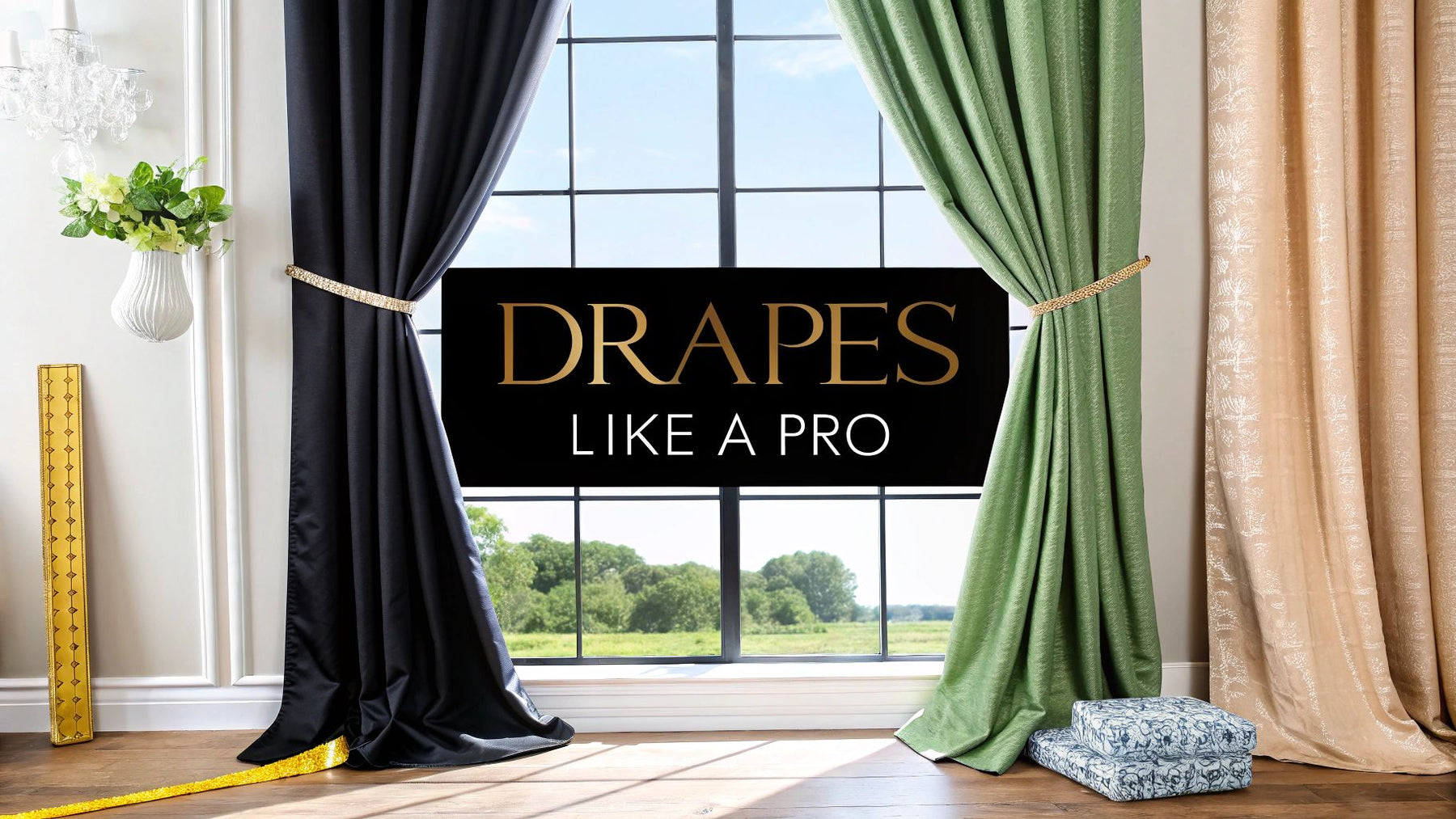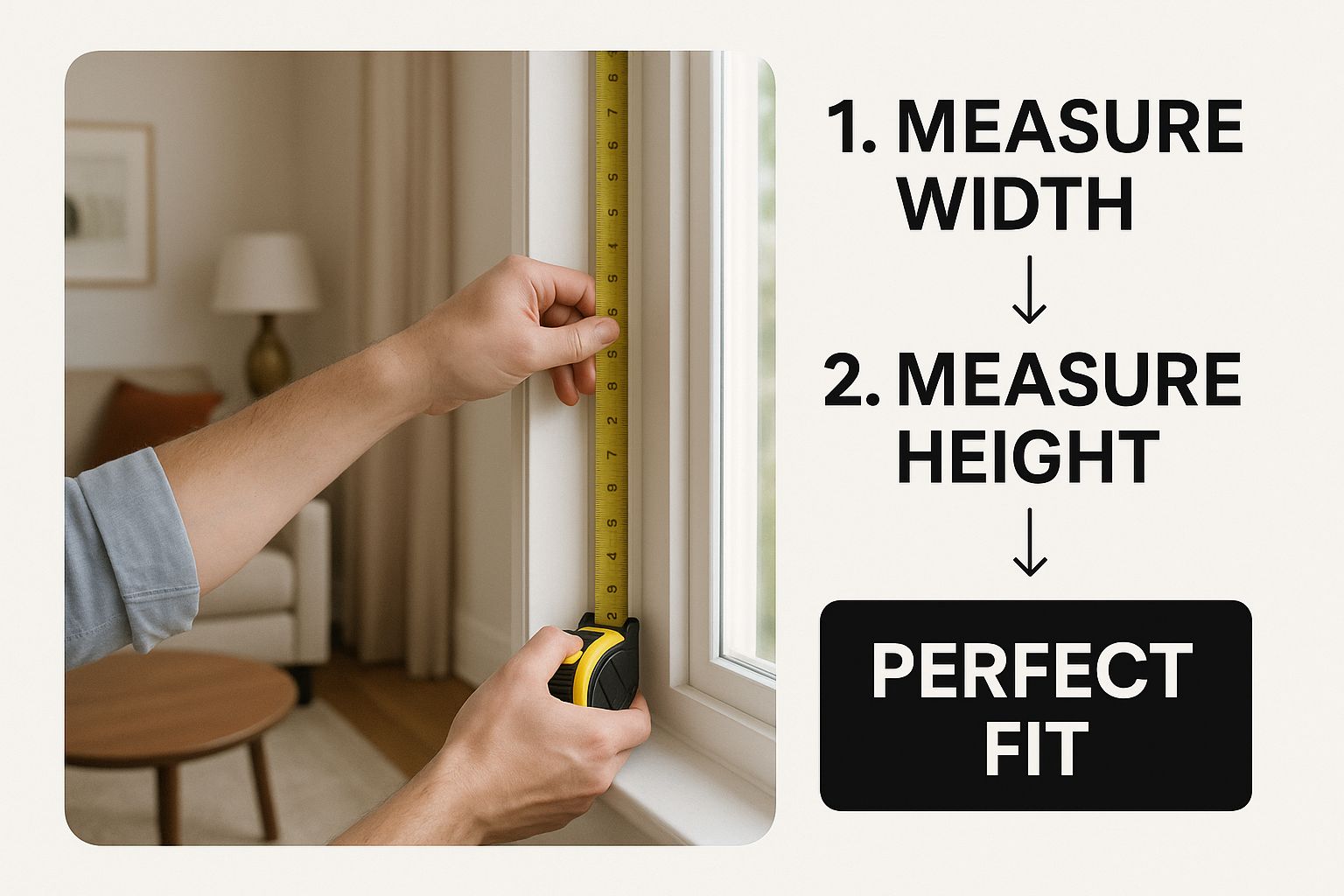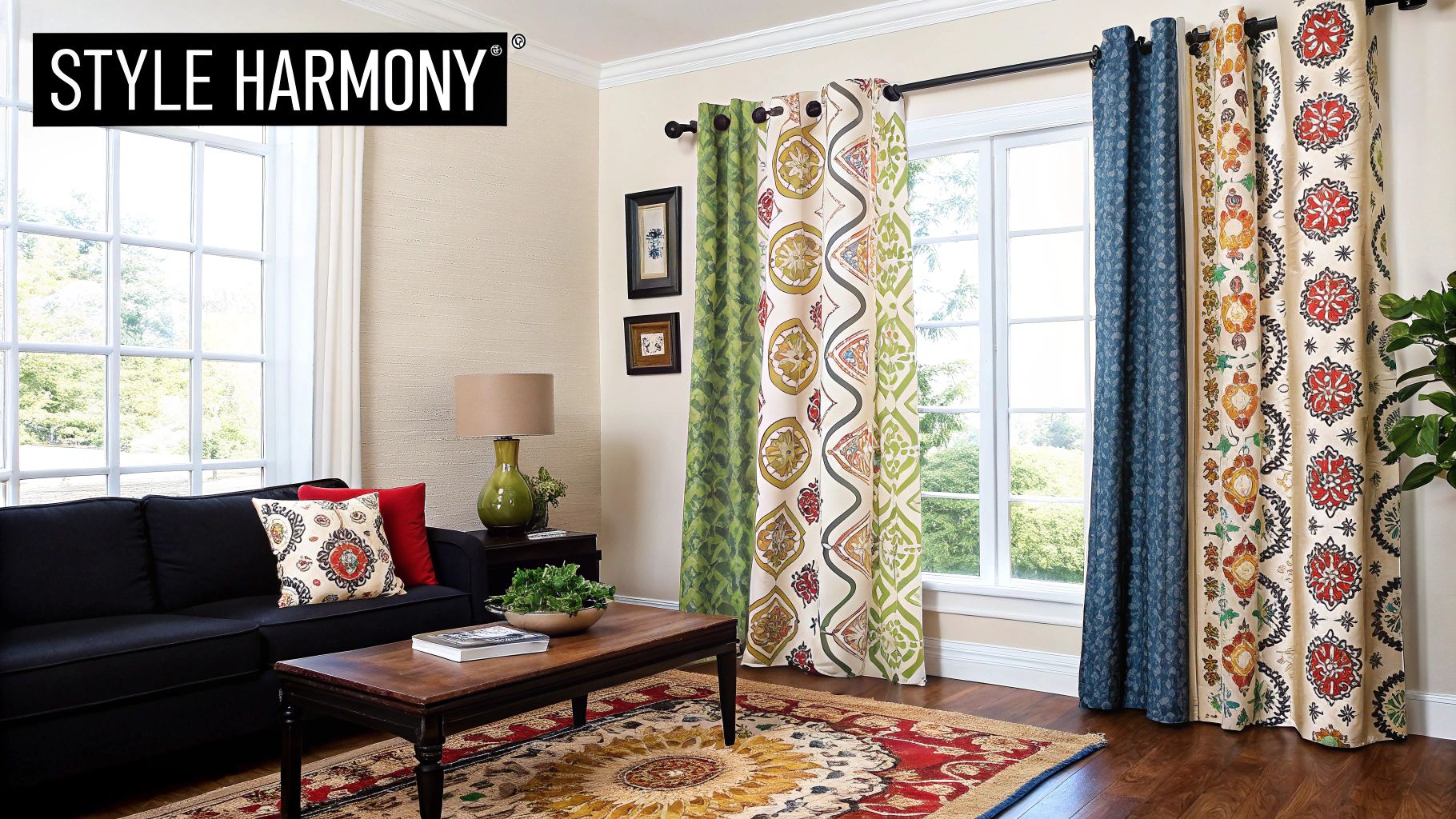
How to Pick Drapes Like an Interior Designer
Choosing the right drapes can feel like a high-stakes design decision, but it doesn’t have to be. The secret to getting it right is focusing on three key elements: function, fabric, and fit. Once you know what you need your drapes to do, you can pick a material that gets the job done and measure for a perfect, professional-looking hang. This guide on how to pick drapes will walk you through every step.
Table of Contents
- Why Drapes Matter More Than You Think
- Step 1: Get Your Measurements Right
- Step 2: Choose the Right Drapery Fabric
- Step 3: Match Drapes to Your Home Decor
- Step 4: Select Hardware and Heading Styles
- Frequently Asked Questions About Picking Drapes
Why Drapes Matter More Than You Think
Drapes are more than just fabric on a wall—they are a core part of your room’s architecture and personality. They can soften hard lines, inject a pop of color, make a low ceiling feel taller, and completely shift the mood with how they play with light. The right pair pulls everything together.
It's a decision homeowners are taking seriously. The global window coverings market was valued at a staggering USD 34.5 billion in 2023 and is projected to grow, according to industry reports on window coverings. This shows just how many people are investing in making their homes both beautiful and functional.
What is the main purpose of your drapes?
Before you get lost in swatches, ask yourself a simple question: what problem do I need these drapes to solve? The short answer is they should serve one (or more) of these key purposes:
- Privacy: To keep your living space private from the outside world.
- Light Control: To filter sunlight gently or achieve a total blackout.
- Insulation: To help keep your room cozy in winter and cool in summer.
- Aesthetics: To add a crucial layer of color, texture, and style.
Your drapes should solve a problem first and be beautiful second. If you need blackout curtains for a bedroom, a sheer linen—no matter how gorgeous—won't be the right choice.
While drapes are a fantastic option, they're just one piece of the puzzle. For a complete overview of all your choices, from blinds to shades, this comprehensive guide on window treatments is a fantastic resource.
Common Drape Styles at a Glance
Choosing a style is about matching the drape’s construction to your room's vibe. This table breaks down common options to help you decide.
| Drape Style | Best For | Vibe | Hardware Note |
|---|---|---|---|
| Rod Pocket | Casual spaces, stationary panels | Relaxed & Traditional | Can be tough to slide open and closed frequently. |
| Grommet Top | Rooms where drapes are opened daily, modern decor | Modern & Industrial | Creates wide, even pleats. Requires a decorative rod. |
| Pinch Pleat | Formal living rooms, dining rooms, master bedrooms | Formal & Classic | Hangs on rings. The pleats are sewn in for a tailored look. |
| Back Tab/Hidden Tab | Achieving a clean, "floating" look | Minimalist & Contemporary | Sits flush against the rod for a seamless appearance. |
| Tab Top | Nurseries, cottage-style or informal rooms | Casual & Rustic | Fabric loops hang directly over the rod. |
Step 1: Get Your Measurements Right
Nothing ruins the look of beautiful new drapes faster than a bad fit. When figuring out how to pick drapes, getting the measurements right is the most critical step. It’s the difference between a high-end, intentional design and a sloppy mistake. Drapes that are too short look awkward, while drapes that are too long become a dusty tripping hazard.
The secret isn't just about accuracy; it’s about creating illusions. Correctly placed hardware and properly measured fabric can make a small window look grander and a low ceiling feel much taller.

As you can see, the key is to measure beyond the frame itself. This little trick creates a sense of height and width, which is a cornerstone of professional interior design.
How to Measure for Drape Width
For a full, luxurious look when closed, your drapes must be wider than your window. The rule of thumb is that the combined width of your drape panels should be 1.5 to 3 times the width of your window frame. A fuller look (3x) is great for formal rooms, while a more casual look (1.5x) works well elsewhere.
Start by measuring the window frame's width, then add 6 to 12 inches on each side. This extra "stack back" space is crucial—it lets the drapes pull completely clear of the window, maximizing natural light and making the window appear much larger.
How to Measure for Drape Length
The length of your drapes completely changes the room's atmosphere. To create the illusion of a taller ceiling, always mount your curtain rod 4 to 6 inches above the window frame. For a more dramatic effect, go higher—place it halfway between the top of the frame and the ceiling.
From that mounting point, measure down to where you want the drapes to end. This decision is all about style:
- Float: The hem hovers about a half-inch above the floor. Clean, practical, and easy to maintain.
- Kiss: The drapes just graze the floor. A very tailored and precise style.
- Puddle: The fabric extends onto the floor by 1 to 3 inches. A romantic, luxurious look for low-traffic areas.
Pro Tip: Don't forget to account for rings or tabs when measuring length! Measure from the bottom of the curtain ring down to your desired endpoint.
For a deeper dive, our guide on measuring windows for drapes offers more expert tips to ensure you get it right every time.
Step 2: Choose the Right Drapery Fabric
The fabric you choose is the soul of your drapes. It dictates how they hang, how they filter light, and how well they insulate the room. Think of it as choosing a personality for your windows—from the airy feel of linen to the rich drama of velvet.
Getting to know the character of each fabric is key to making a choice that’s not just beautiful but also perfectly practical for your home.
Common Drapery Fabrics and Their Uses
Here’s a breakdown of the most popular materials. The best fabric for your drapes depends on your room's function and your lifestyle.
- Cotton: The reliable workhorse. Cotton is versatile, easy to clean, and offers a crisp look that fits any decor. It’s an easy go-to for living rooms and bedrooms.
- Linen: For a relaxed, breezy atmosphere, choose linen. Its natural texture adds depth and an organic touch, but it wrinkles easily (which is part of its charm).
- Velvet: The ultimate choice for drama and luxury. Velvet is heavy, thick, and a champion at blocking light and insulating against drafts and sound.
- Silk: Pure elegance with a shimmery finish. Silk is delicate and prone to sun damage, so it must always be lined. For better durability, faux silk is a fantastic alternative.
Synthetics and Performance Fabrics
Modern synthetic fabrics like polyester and its blends are incredibly popular for good reason. They are highly durable, resistant to wrinkling and fading, and often more affordable. These are an excellent pick for rooms that get lots of sun or for high-traffic areas like a child's playroom. For a full comparison, you can explore the different curtain cloth types.
Choosing a fabric isn't just a style choice; it's an energy-saving one too. The right material can significantly impact your home's thermal efficiency.
In fact, some fabrics with dense weaves or special solar-reflective coatings can reduce heat transfer, potentially lowering a home's energy consumption. This trend has fueled a rise in sustainable textiles for window treatments, a topic explored in market research on window coverings.
Drapery Fabric Comparison Chart
This quick-glance table helps you weigh the pros and cons of common drapery fabrics.
| Fabric Type | Light Control | Durability | Best Use Case |
|---|---|---|---|
| Cotton | Moderate | High | Living rooms, bedrooms, kitchens |
| Linen | Light to Moderate | Medium | Casual living spaces, sunrooms |
| Velvet | Excellent (Blackout) | High | Formal dining rooms, bedrooms, home theaters |
| Silk / Faux Silk | Poor (Must be lined) | Low / High | Formal living rooms, elegant bedrooms |
| Polyester | Good to Excellent | Very High | High-traffic areas, sunny rooms, kids' rooms |
Step 3: Match Drapes to Your Home Decor
Your drapes are a design powerhouse. The right color and pattern can instantly pull a disjointed space together. The big question is: should your drapes blend in or stand out?
Matching drapes to the wall color creates a calm, monochromatic look that can make a room feel larger. In contrast, choosing a bold, contrasting color turns your windows into a stunning focal point, perfect for injecting personality into the space.

How to Coordinate Drapery with Existing Decor
Your drapes need to be a team player, coordinating with your sofa, rug, and chairs. You don't need a perfect match—in fact, that can look dated. A great designer trick is to pull a secondary color from your area rug or a throw pillow and use that for your drapes.
For more ideas, our guide on the best curtain colors for your living room has specific strategies to explore.
How to Mix and Match Patterns
Bringing patterns into the mix adds incredible visual interest, but getting the scale right is crucial. A large, bold pattern can overwhelm a small room, while a tiny pattern might get lost in a grand space. A good rule of thumb is to mix the scale of your patterns.
- If your drapes have a large pattern: Pair them with a solid-colored rug or one with a small, subtle pattern.
- If your drapes have a small pattern: Balance them with a rug that has a larger, more graphic design.
The goal is to create visual harmony, not competition. Let one pattern take the lead while the other plays a supporting role.
Drapes play a key role in shaping our perception of space. For more tips, check out these ideas on designing small living rooms.
Step 4: Select Hardware and Heading Styles
The details are what truly elevate a design. Drapery hardware and heading styles give your window treatments a polished, professional look and determine how smoothly they function.
Think of your curtain rod as the foundation. It must be strong enough to hold your fabric without sagging, and its style should complement the room's decor. A sleek black metal rod fits a modern space, while a warm wood rod suits a traditional home.
How to Choose Drapery Hardware
Hardware is more than just the rod—it includes the finials (decorative ends), brackets, and rings.
- Match Your Metals: Try to match the hardware to other metal or wood finishes in the room for a cohesive feel.
- Prioritize Functionality: If you open and close your drapes daily, a smooth rod with curtain rings is best. A rod pocket style is better for decorative panels that stay in one place.
Insider Tip: Always extend your curtain rod 6 to 12 inches past the window frame on each side. This allows the drapes to "stack back" against the wall, maximizing light and making the window feel larger.
Understanding Drapery Heading Styles
The "heading" is the very top of the drape that connects to the rod. This choice makes a huge difference in the curtain's fullness and overall style.
- Rod Pocket: A channel is sewn into the fabric for the rod to slide through. It creates a soft, gathered, casual look.
- Grommet Top: Metal rings set into the fabric create deep, uniform folds. This is a clean, modern style that’s easy to operate.
- Pinch Pleat: Fabric is gathered and stitched into tailored pleats. It’s a classic, formal style that offers a structured appearance.
Frequently Asked Questions About Picking Drapes
Even after nailing the basics, a few questions often come up. Getting these final details right will ensure you love your drapes for years to come.

How do I clean my drapes?
The short answer is to check the care label on the fabric. Cotton and polyester can often be machine washed on a gentle cycle and hung to dry. Delicate materials like silk, velvet, or some linens are typically dry clean only to avoid damage. For regular maintenance, use your vacuum's soft brush attachment monthly to remove dust.
Can I layer drapes with other window treatments?
Yes, absolutely! Layering drapes over sheer curtains or blinds adds depth, style, and superior function. This combination gives you ultimate control over light and privacy. You'll need a double curtain rod, which has two separate rods on one set of brackets, to hang both layers independently.
Are expensive drapes worth the investment?
In many cases, yes. What you’re paying for with high-quality drapes is superior fabric and construction. Denser, more durable materials hang better, last longer, and often provide better insulation and light-blocking. However, many affordable options in polyester or cotton blends offer fantastic style and durability. The key is to invest in the features that matter most to you.
Should drapes touch the floor?
The most polished and intentional looks either "kiss" the floor or puddle slightly. Drapes that hover a half-inch above the floor ("float") are the most practical option for homes with kids or pets. Generally, avoid drapes that hang high above the floor, as this can make your ceilings feel lower.
Ready to find the perfect drapes that reflect your style and meet your needs? Explore the beautiful and accessible collection at Joey'z Shopping. We offer a wide range of high-quality fabrics, styles, and hardware to complete any room in your home.
